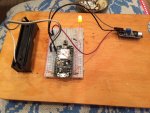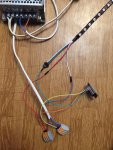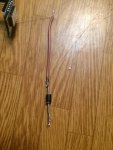#include <FastLED.h>
#include <ESP8266WiFi.h>
#include <WiFiUDP.h>
#include "reactive_common.h"
#define FASTLED_INTERRUPT_RETRY_COUNT 0
#define FASTLED_ALLOW_INTERRUPTS 0
#define LED_PIN 2
#define NUM_LEDS 61
#define MIC_LOW 0
#define MIC_HIGH 644
#define SAMPLE_SIZE 20
#define LONG_TERM_SAMPLES 250
#define BUFFER_DEVIATION 400
#define BUFFER_SIZE 3
#define LAMP_ID 1
WiFiUDP UDP;
int ihue = 255; //-HUE (0-255)
int thissat = 100; //-FX LOOPS DELAY VAR
int thisdelay = 35; //-FX LOOPS DELAY VAR
float tcount = 0.0; //-INC VAR FOR SIN LOOPS
int lcount = 1; //-ANOTHER COUNTING VAR
int idex = 1; //-LED INDEX (0 to NUM_LEDS-1
int thishue = 1; //-FX LOOPS DELAY VAR
int bouncedirection = 1; //-SWITCH FOR COLOR BOUNCE (0-1)
int isat = 0; //-SATURATION (0-255)
const char *ssid = "sound_reactive"; // The SSID (name) of the Wi-Fi network you want to connect to
const char *password = "123456789"; // The password of the Wi-Fi network
CRGB leds[NUM_LEDS];
struct averageCounter *samples;
struct averageCounter *longTermSamples;
struct averageCounter* sanityBuffer;
float globalHue;
float globalBrightness = 255;
int hueOffset = 120;
float fadeScale = 1.3;
float hueIncrement = 0.7;
struct led_command {
uint8_t opmode;
uint32_t data;
};
unsigned long lastReceived = 0;
unsigned long lastHeartBeatSent;
const int heartBeatInterval = 100;
bool fade = false;
struct led_command cmd;
void connectToWifi();
void one_color_all(int cred, int cgrn, int cblu) { //-SET ALL LEDS TO ONE COLOR
for (int i = 0 ; i < NUM_LEDS; i++ ) {
leds[i].setRGB( cred, cgrn, cblu);
}
}
void setPixel(int Pixel, byte red, byte green, byte blue) {
leds[Pixel].r = red;
leds[Pixel].g = green;
leds[Pixel].b = blue;
}
void setAll(byte red, byte green, byte blue) {
for (int i = 0; i < NUM_LEDS; i++ ) {
setPixel(i, red, green, blue);
}
FastLED.show();
}
void setup()
{
globalHue = 0;
samples = new averageCounter(SAMPLE_SIZE);
longTermSamples = new averageCounter(LONG_TERM_SAMPLES);
sanityBuffer = new averageCounter(BUFFER_SIZE);
while(sanityBuffer->setSample(250) == true) {}
while (longTermSamples->setSample(200) == true) {}
FastLED.addLeds<NEOPIXEL, LED_PIN>(leds, NUM_LEDS);
Serial.begin(115200); // Start the Serial communication to send messages to the computer
delay(10);
Serial.println('\n');
WiFi.begin(ssid, password); // Connect to the network
Serial.print("Connecting to ");
Serial.print(ssid);
Serial.println(" ...");
connectToWifi();
sendHeartBeat();
UDP.begin(7001);
}
void sendHeartBeat() {
struct heartbeat_message hbm;
hbm.client_id = LAMP_ID;
hbm.chk = 77777;
Serial.println("Sending heartbeat");
IPAddress ip(192,168,4,1);
UDP.beginPacket(ip, 7171);
int ret = UDP.write((char*)&hbm,sizeof(hbm));
printf("Returned: %d, also sizeof hbm: %d \n", ret, sizeof(hbm));
UDP.endPacket();
lastHeartBeatSent = millis();
}
void loop()
{
if (millis() - lastHeartBeatSent > heartBeatInterval) {
sendHeartBeat();
}
int packetSize = UDP.parsePacket();
if (packetSize)
{
UDP.read((char *)&cmd, sizeof(struct led_command));
lastReceived = millis();
}
if(millis() - lastReceived >= 5000)
{
connectToWifi();
}
int opMode = cmd.opmode;
int analogRaw = cmd.data;
switch (opMode) {
case 1:
fade = false;
soundReactive(analogRaw);
break;
case 2:
fade = false;
allWhite();
break;
case 3:
chillFade();
break;
case 4: SnowSparkle(0x10, 0x10, 0x10, thisdelay, random(100, 1000)); break;
case 5: new_rainbow_loop(); break;
}
}
void allWhite() {
for (int i = 0; i < NUM_LEDS; i++) {
leds[i] = CRGB(30, 0, 0);
}
delay(5);
FastLED.show();
}
void SnowSparkle(byte red, byte green, byte blue, int SparkleDelay, int SpeedDelay) {
setAll(red, green, blue);
int Pixel = random(NUM_LEDS);
setPixel(Pixel, 0xff, 0xff, 0xff);
FastLED.show();
delay(SparkleDelay);
setPixel(Pixel, red, green, blue);
FastLED.show();
delay(SpeedDelay);
}
void new_rainbow_loop() { //-m88-RAINBOW FADE FROM FAST_SPI2
ihue -= 1;
fill_rainbow( leds, NUM_LEDS, ihue );
LEDS.show();
delay(thisdelay);
}
void chillFade() {
static int fadeVal = 0;
static int counter = 0;
static int from[3] = {0, 234, 255};
static int to[3] = {255, 0, 214};
static int i, j;
static double dsteps = 500.0;
static double s1, s2, s3, tmp1, tmp2, tmp3;
static bool reverse = false;
if (fade == false) {
for (int i = 0; i < NUM_LEDS; i++) {
leds[i] = CRGB(from[0], from[1], from[2]);
}
s1 = double((to[0] - from[0])) / dsteps;
s2 = double((to[1] - from[1])) / dsteps;
s3 = double((to[2] - from[2])) / dsteps;
tmp1 = from[0], tmp2 = from[1], tmp3 = from[2];
fade = true;
}
if (!reverse)
{
tmp1 += s1;
tmp2 += s2;
tmp3 += s3;
}
else
{
tmp1 -= s1;
tmp2 -= s2;
tmp3 -= s3;
}
for (j = 0; j < NUM_LEDS; j++)
leds[j] = CRGB((int)round(tmp1), (int)round(tmp2), (int)round(tmp3));
FastLED.show();
delay(5);
counter++;
if (counter == (int)dsteps) {
reverse = !reverse;
tmp1 = to[0], tmp2 = to[1], tmp3 = to[2];
counter = 0;
}
}
void soundReactive(int analogRaw) {
int sanityValue = sanityBuffer->computeAverage();
if (!(abs(analogRaw - sanityValue) > BUFFER_DEVIATION)) {
sanityBuffer->setSample(analogRaw);
}
analogRaw = fscale(MIC_LOW, MIC_HIGH, MIC_LOW, MIC_HIGH, analogRaw, 0.4);
if (samples->setSample(analogRaw))
return;
uint16_t longTermAverage = longTermSamples->computeAverage();
uint16_t useVal = samples->computeAverage();
longTermSamples->setSample(useVal);
int diff = (useVal - longTermAverage);
if (diff > 5)
{
if (globalHue < 235)
{
globalHue += hueIncrement;
}
}
else if (diff < -5)
{
if (globalHue > 2)
{
globalHue -= hueIncrement;
}
}
int curshow = fscale(MIC_LOW, MIC_HIGH, 0.0, (float)NUM_LEDS, (float)useVal, 0);
//int curshow = map(useVal, MIC_LOW, MIC_HIGH, 0, NUM_LEDS)
for (int i = 0; i < NUM_LEDS; i++)
{
if (i < curshow)
{
leds[i] = CHSV(globalHue + hueOffset + (i * 2), 255, 255);
}
else
{
leds[i] = CRGB(leds[i].r / fadeScale, leds[i].g / fadeScale, leds[i].b / fadeScale);
}
}
delay(5);
FastLED.show();
}
void connectToWifi() {
WiFi.mode(WIFI_STA);
for (int i = 0; i < NUM_LEDS; i++)
{
leds[i] = CHSV(0, 0, 0);
}
leds[0] = CRGB(0, 255, 0);
FastLED.show();
int i = 0;
while (WiFi.status() != WL_CONNECTED)
{ // Wait for the Wi-Fi to connect
delay(1000);
Serial.print(++i);
Serial.print(' ');
}
Serial.println('\n');
Serial.println("Connection established!");
Serial.print("IP address:\t");
Serial.println(WiFi.localIP()); // Send the IP address of the ESP8266 to the computer
leds[0] = CRGB(0, 0, 255);
FastLED.show();
lastReceived = millis();
}
float fscale(float originalMin, float originalMax, float newBegin, float newEnd, float inputValue, float curve)
{
float OriginalRange = 0;
float NewRange = 0;
float zeroRefCurVal = 0;
float normalizedCurVal = 0;
float rangedValue = 0;
boolean invFlag = 0;
// condition curve parameter
// limit range
if (curve > 10)
curve = 10;
if (curve < -10)
curve = -10;
curve = (curve * -.1); // - invert and scale - this seems more intuitive - postive numbers give more weight to high end on output
curve = pow(10, curve); // convert linear scale into lograthimic exponent for other pow function
// Check for out of range inputValues
if (inputValue < originalMin)
{
inputValue = originalMin;
}
if (inputValue > originalMax)
{
inputValue = originalMax;
}
// Zero Refference the values
OriginalRange = originalMax - originalMin;
if (newEnd > newBegin)
{
NewRange = newEnd - newBegin;
}
else
{
NewRange = newBegin - newEnd;
invFlag = 1;
}
zeroRefCurVal = inputValue - originalMin;
normalizedCurVal = zeroRefCurVal / OriginalRange; // normalize to 0 - 1 float
// Check for originalMin > originalMax - the math for all other cases i.e. negative numbers seems to work out fine
if (originalMin > originalMax)
{
return 0;
}
if (invFlag == 0)
{
rangedValue = (pow(normalizedCurVal, curve) * NewRange) + newBegin;
}
else // invert the ranges
{
rangedValue = newBegin - (pow(normalizedCurVal, curve) * NewRange);
}
return rangedValue;
}





